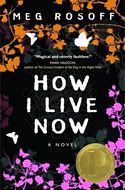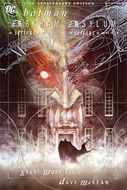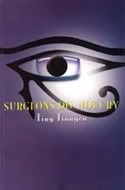Reviews: How I Live Now, Exquisite Corpse, Arkham Asylum, Surgeons Do Not Cry
I was using Multiply to post reviews I could compile on here, but it turns out that posting over there makes me write longer reviews. Whups.

How I Live Now by Meg Rosoff
In an alternate present (or perhaps the near future), 15-year-old Daisy is sent from Manhattan to England to visit her aunt and cousins she's never even met. When England is attacked and occupied by an unnamed enemy, the cousins find themselves on their own. Power fails, systems fail. As they grow more isolated, the farm becomes a kind of Eden, with no rules. Until the war arrives in their midst.
I picked this up because la_sonnambula recommended it more than a year ago as an alternative to Twilight and it's Mary Sue Bella. How I Live Now is categorized under "Teens" in the bookstore, but the themes are adult.
Also, the_bumper_car, now that I think about it this book may start out as a cozy catastrophe, but it rapidly loses the adjective.
Written in a stream of consciousness style, Daisy's voice is resonant. She is humorous and authentic. The story is captivating and poignant, and issues that would normally bring out the angst (eating disorders, sex, war for heaven's sake) are approached in a subtle and believable way because of Daisy's slightly detached narration. It reminds me of Elie Wiesel's Night. And the descriptions of the English countryside are wonderfully vivid.
I admit I was reminded of Twilight because of the character Edmond and his siblings, children so perceptive it borders on telepathy. But the characters are far more human (DUH Eula, they're not VAMPIRES) and readable.
Some may find Rosoff's writing style off-putting, as she doesn't use punctuation marks and, being stream of consciousness, sentences can run quite long. (If you've read José Saramago's Blindness, it's a mild version of that. Besides which, I've read enough blogs to read thought streams comfortably.) The book's conclusion of the book is dramatic but sudden. Still, its raw, unfinished quality is fitting.

Exquisite Corpse by Poppy Z. Brite
To serial slayer Andrew Compton, murder is an art, the most intimate art. After feigning his own death to escape from prison, Compton makes his way to the United States with the ambition of bringing his art to new heights. Tortured by his own perverse desires, drawn to possess and destroy young boys, Compton inadvertently joins forces with Jay Byrne, a dissolute playboy who has pushed his art to limits even Compton hadn't previously imagined. Together, Compton and Byrne set their sights on an exquisite young Vietnamese-American runaway, Tran, whom they deem to be the perfect victim.
No, this book is not that exquisite corpse. I picked this up because I'd heard good things about Poppy Z. Brite and I wanted to try her out. I did not know that her trademarks include using gay men as main characters, graphic sexual descriptions, and an often wry treatment of gruesome events. And I don't think I read the blurb very well because I had no clue that I was going to read a love story about two serial killers.
Neither did I know the level of detail I was in for. Exquisite Corpse is akin to the darkfic genre of fanfic. But fanfic is not nearly as graphic as Brite. Some paragraphs read like a crazy anatomy reviewer. Several passages literally made me squirm. This, men, is true gore.
The first chapter, which deals with Andrew Compton's escape from prison, is particularly difficult not to finish in one sitting.
The setting of New Orleans and the world's reaction to the rise of AIDS makes for an interesting background to the serial killers' tales.
However, there is no actual plot. No one changes, except maybe for Jay Byrne. It's like a short story that has given chase but ends up running in a circle. You run enough laps to have it reach novel length, but you end up with what you started. Really, the book's most striking (and perhaps appealing) quality is its shock value.

Arkham Asylum: A Serious House on Serious Earth by Grant Morrison (with Dave McKean)
A hard-hitting psychological horror story featuring Batman and virtually all the inmates of Arkham Asylum, the house for the criminally insane. Led by the Joker, the inmates -- Two Face, the Mad Hatter, Killer Croc, Clayface, Scarecrow, and more -- take over the asylum and seize control of the staff. They're willing to release the hostages, but only if their one demand is met: Batman must be turned over to them, and become one of their own. During his run through this absurd gauntlet, the Dark Knight's own sanity is placed in jeopardy.
Though less plot-driven than other notable Batman creations (The Long Halloween, The Dark Knight Returns), Arkham Asylum is no less intriguing. It is more of Grant Morrison's reflection on Batman's psyche and that of his anti-thesis, the Joker. And I love what Morrison's done to Two Face.
Dave McKean's art is just beautiful. It's paintings man, real paintings. Each panel makes me wish I had it on canvas to hang on my wall.
The 15th anniversary edition includes Morrison's complete original script. Annotations by both himself and editor Karen Berger give you a glimpse of Morrison's thought process, the little details of symbolism he wanted on the panels, and it made me appreciate the comic even more. Morrison even drew thumbnail breakdowns of the ENTIRE comic, which McKean used as guides for his final rendition.
You can download a preview of Arkham Asylum here.

Surgeons Do Not Cry by Ting Tiongco
I picked this up at the last bookfair. Once you get past the literal/obtuse (depends how you look at it) eye of Ra cover and the slightly chauvinistic title, Surgeons Do Not Cry is a wonderfully insightful read.
The book is actually a compilation of the surgeon's “Child of the Sun” column pieces in MindaNews. Read the articles in the order they are printed, for the memoir tracks Jose “Ting” M. Tiongco's development from student to doctor.
Tiongco, a true blue Atenean from Ateneo de Davao to de Manila, was one of the extraordinary few who made it into UP College of Medicine. He eloquently and wittily relates his journey to becoming a surgeon, from his choice of ADMU for his undergrad course to his residency at UP PGH.
You get the impression Tiongco was somewhat of a legend in his day, mostly because of his extracurricular activities: organizing a walking blood bank drive, starting "Kissing Rounds," writing his reports in another language. I was also amused to read that things I'd previously only read about in textbooks really do happen (eg, fractured penises).
The background of a changing Philippine society gives the book an added dimension. Partly set in the Marcos era, we are given snapshots of riots, raids, and people forced go into hiding. Tiongco's fierce idealism shines through it all.
You know how PGH doctors are notorious for being cold and unfeeling? This guy proves the exception. Filled with humor and emotion, the book describes the kind of doctor I'd like to be: never forgetting that the patient is first and foremost another human being.

How I Live Now by Meg Rosoff
In an alternate present (or perhaps the near future), 15-year-old Daisy is sent from Manhattan to England to visit her aunt and cousins she's never even met. When England is attacked and occupied by an unnamed enemy, the cousins find themselves on their own. Power fails, systems fail. As they grow more isolated, the farm becomes a kind of Eden, with no rules. Until the war arrives in their midst.
I picked this up because la_sonnambula recommended it more than a year ago as an alternative to Twilight and it's Mary Sue Bella. How I Live Now is categorized under "Teens" in the bookstore, but the themes are adult.
Also, the_bumper_car, now that I think about it this book may start out as a cozy catastrophe, but it rapidly loses the adjective.
Written in a stream of consciousness style, Daisy's voice is resonant. She is humorous and authentic. The story is captivating and poignant, and issues that would normally bring out the angst (eating disorders, sex, war for heaven's sake) are approached in a subtle and believable way because of Daisy's slightly detached narration. It reminds me of Elie Wiesel's Night. And the descriptions of the English countryside are wonderfully vivid.
I admit I was reminded of Twilight because of the character Edmond and his siblings, children so perceptive it borders on telepathy. But the characters are far more human (DUH Eula, they're not VAMPIRES) and readable.
Some may find Rosoff's writing style off-putting, as she doesn't use punctuation marks and, being stream of consciousness, sentences can run quite long. (If you've read José Saramago's Blindness, it's a mild version of that. Besides which, I've read enough blogs to read thought streams comfortably.) The book's conclusion of the book is dramatic but sudden. Still, its raw, unfinished quality is fitting.

Exquisite Corpse by Poppy Z. Brite
To serial slayer Andrew Compton, murder is an art, the most intimate art. After feigning his own death to escape from prison, Compton makes his way to the United States with the ambition of bringing his art to new heights. Tortured by his own perverse desires, drawn to possess and destroy young boys, Compton inadvertently joins forces with Jay Byrne, a dissolute playboy who has pushed his art to limits even Compton hadn't previously imagined. Together, Compton and Byrne set their sights on an exquisite young Vietnamese-American runaway, Tran, whom they deem to be the perfect victim.
No, this book is not that exquisite corpse. I picked this up because I'd heard good things about Poppy Z. Brite and I wanted to try her out. I did not know that her trademarks include using gay men as main characters, graphic sexual descriptions, and an often wry treatment of gruesome events. And I don't think I read the blurb very well because I had no clue that I was going to read a love story about two serial killers.
Neither did I know the level of detail I was in for. Exquisite Corpse is akin to the darkfic genre of fanfic. But fanfic is not nearly as graphic as Brite. Some paragraphs read like a crazy anatomy reviewer. Several passages literally made me squirm. This, men, is true gore.
The first chapter, which deals with Andrew Compton's escape from prison, is particularly difficult not to finish in one sitting.
The setting of New Orleans and the world's reaction to the rise of AIDS makes for an interesting background to the serial killers' tales.
However, there is no actual plot. No one changes, except maybe for Jay Byrne. It's like a short story that has given chase but ends up running in a circle. You run enough laps to have it reach novel length, but you end up with what you started. Really, the book's most striking (and perhaps appealing) quality is its shock value.

Arkham Asylum: A Serious House on Serious Earth by Grant Morrison (with Dave McKean)
A hard-hitting psychological horror story featuring Batman and virtually all the inmates of Arkham Asylum, the house for the criminally insane. Led by the Joker, the inmates -- Two Face, the Mad Hatter, Killer Croc, Clayface, Scarecrow, and more -- take over the asylum and seize control of the staff. They're willing to release the hostages, but only if their one demand is met: Batman must be turned over to them, and become one of their own. During his run through this absurd gauntlet, the Dark Knight's own sanity is placed in jeopardy.
Though less plot-driven than other notable Batman creations (The Long Halloween, The Dark Knight Returns), Arkham Asylum is no less intriguing. It is more of Grant Morrison's reflection on Batman's psyche and that of his anti-thesis, the Joker. And I love what Morrison's done to Two Face.
Dave McKean's art is just beautiful. It's paintings man, real paintings. Each panel makes me wish I had it on canvas to hang on my wall.
The 15th anniversary edition includes Morrison's complete original script. Annotations by both himself and editor Karen Berger give you a glimpse of Morrison's thought process, the little details of symbolism he wanted on the panels, and it made me appreciate the comic even more. Morrison even drew thumbnail breakdowns of the ENTIRE comic, which McKean used as guides for his final rendition.
You can download a preview of Arkham Asylum here.

Surgeons Do Not Cry by Ting Tiongco
I picked this up at the last bookfair. Once you get past the literal/obtuse (depends how you look at it) eye of Ra cover and the slightly chauvinistic title, Surgeons Do Not Cry is a wonderfully insightful read.
The book is actually a compilation of the surgeon's “Child of the Sun” column pieces in MindaNews. Read the articles in the order they are printed, for the memoir tracks Jose “Ting” M. Tiongco's development from student to doctor.
Tiongco, a true blue Atenean from Ateneo de Davao to de Manila, was one of the extraordinary few who made it into UP College of Medicine. He eloquently and wittily relates his journey to becoming a surgeon, from his choice of ADMU for his undergrad course to his residency at UP PGH.
You get the impression Tiongco was somewhat of a legend in his day, mostly because of his extracurricular activities: organizing a walking blood bank drive, starting "Kissing Rounds," writing his reports in another language. I was also amused to read that things I'd previously only read about in textbooks really do happen (eg, fractured penises).
The background of a changing Philippine society gives the book an added dimension. Partly set in the Marcos era, we are given snapshots of riots, raids, and people forced go into hiding. Tiongco's fierce idealism shines through it all.
You know how PGH doctors are notorious for being cold and unfeeling? This guy proves the exception. Filled with humor and emotion, the book describes the kind of doctor I'd like to be: never forgetting that the patient is first and foremost another human being.